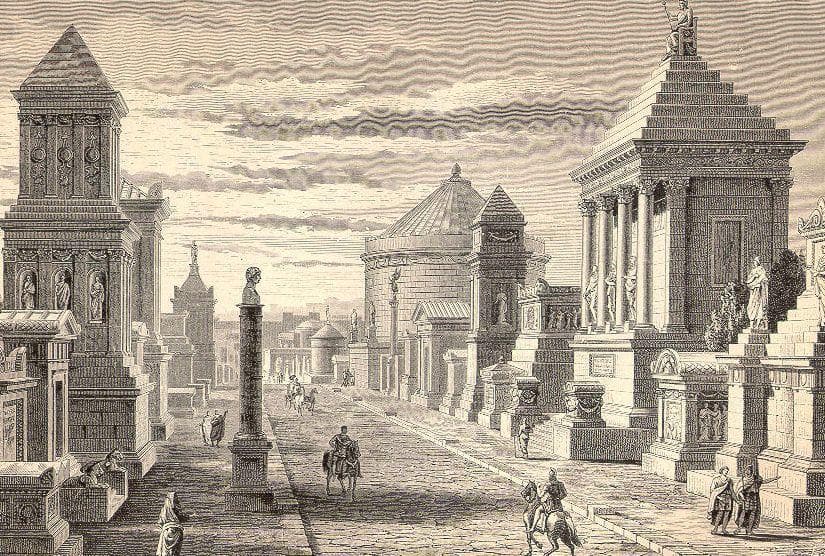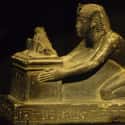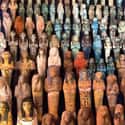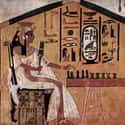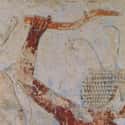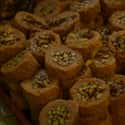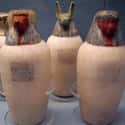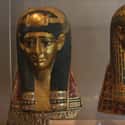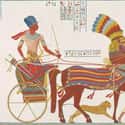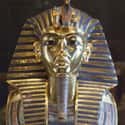-
(#1) Enormous Boats
Egyptian pharaohs needed to sail through the night on a barge, so of course some had boats buried with them. In particular, the Old Kingdom Pharaoh Khufu, buried in the Great Pyramid at Giza, had his burial excavated, only for archaeologists to uncover more than 1,200 pieces of a giant boat nearby. Today, they've reassembled the ship, which is now on display in Egypt. It's 144 feet long, made mostly of cedar imported from Lebanon, and doesn't contain a single nail, using some fancy joining techniques that would put modern engineers to shame.
-
(#2) Sarcophagus
King Tut was buried not just with a lot of stuff, but also with two unborn fetuses. In fact, they were his own biological children, possibly stillborn twins that his wife, Queen Ankhesenamun, gave birth to. One fetus was aged five months, the other between seven and nine months. Alternatively, Egyptologist Zahi Hawass doesn't believe these were Tut's kids, but someone else's children that would be reborn in the afterlife.
-
(#3) Human Sacrifices
Naturally, the ancient kings needed people to be their servants or slaves in the afterlife. How did they do that? The first pharaohs might have sacrificed real-life humans, who would in theory come back to life in the afterlife. For example, one of the very first rulers, King Aha, supposedly died after being gored to death by a hippo. To accompany Aha into the afterlife, some courtiers, retainers, and slaves downed poison and were buried with him.
-
(#4) Statues Of Servants
Every good pharaoh needed servants in the afterlife, but it wasn't practical - or humane - to sacrifice a lot of people and stick their corpses in the tomb. Instead of commiting mass murders, the clever Egyptians crafted tons of tiny human figurines, called ushabti, that would come alive to serve their kings in the afterlife. Originally, the ushabti were depicted as mummies, but they eventually took on more unique forms and professions, like nobles or farmers.
-
(#5) Elaborate Board Games
Pharaohs needed to have fun after death - don't we all? - so they stocked up on board games in their tombs. One really popular one was senet, translated as "passing." It was sort of an ancient version of Parcheesi. Folks played them on many-squared boards; if you were rich, the boards might be made out of fancy materials like faience. Fun!
-
(#6) Murderous Throwing Sticks
The ancient Egyptians killed waterfowl with throwing sticks that bore some similarities to Australian boomerangs. The upper-class noblemen often went hunting on the Nile, both to catch food and for fun. As a result, this leisurely activity was often shown on high-ranking mens' tomb walls, so they could do the same fun stuff in the afterlife.
-
(#7) Tons And Tons Of Food
What better way to start off your life in the afterlife than with a feast? Pharaohs apparently felt the same way, and their tombs were jam-packed full of goodies. The Egyptians basically mummified their meat, drying it out with natron salt and adding some resins. In Tut's tomb, there were also over 100 baskets with barley, figs, grapes, melons, and more tasty treats. He also loved a glass of wine, as evidenced by the many jars of it in his tomb.
-
(#8) Jars Full Of Body Parts
To live on in the afterlife, the deceased had to have their body parts buried with them, but their organs were removed during mummification, so priests stuck four major organs (liver, stomach, lungs, and intestines), dried out with natron, in containers called canopic jars. Each jar was under the auspices of a god, one of the four sons of Horus, each of whom had a protector goddess counterpart.
-
(#9) Cosmetics, Wigs, And Perfumes
As anyone would, Egyptians wanted to look good and smell good in the afterlife, so they brought tons of cosmetics with them. Tombs contained makeup kits, used by both men and women, rich and poor. Perhaps the most famous cosmetic, eyeliner (aka kohl), appeared in pots pretty much everywhere. Scent was just as important as looks; salves and perfumes were super-popular. Tut's tomb contained a stunning perfume box, for example, and clearly everyone loved a good wig, as witnessed by the many toppers found in eternal resting places.
-
(#10) Fancy Chariots And Even Some Not So Fancy Chariots
In order to gallop out the hunt in the afterlife, pharaohs needed chariots...and boy, did they have them. King Tut had six buried in his tomb with him: three for decorative use, and three for everyday affairs. It would be hard to stick fully-constructed chariots in a low-ceilinged tomb, so they were dismantled before being stowed away for eternity. The technology, which reached Egypt in the second millennium B.C.E., was a favorite one to use in both war and play.
-
(#11) Elaborate And Priceless Masks
King Tut's golden funeral mask is perhaps the most famous facial covering from the ancient world, but it's far from the only one. Mummies, especially upper-class ones, would boast masks that symbolized the body's transition from the human realm to the divine. In particular, pharaohs wore golden masks to symbolize their ascent to godhead (gold was seen as the flesh of the divine) and to invoke magical protection.
-
(#12) Sacred Jewelry
Mummies had tons of amulets and sacred jewels placed into their linen folds. Why? To protect the deceased in the deadly afterlife. A few types of amulets were super-common: for example, the djed pillar, a symbol of Osiris, god of the dead, that represented stability. The materials out of which these holy pieces were made were thought to have magical properties; the amulets were believed to have apotropaic properties, meaning they averted bad luck.
New Random Displays Display All By Ranking
About This Tool
Ancient Egypt was a civilization that believed in the afterlife and reincarnation. For this reason, they developed a set of unique funeral customs. As the supreme ruler in the world, ancient pharaohs enjoyed the best treatment. The ancient Egyptians also believed that the pharaoh would face greater challenges than mortals after death. Over the centuries, according to historical records and archaeological discoveries, archaeologists have found many bizarre funerary objects in many pharaoh tombs.
When talking about the pyramids of Egypt, people will think of the appalling curse of the ancient Egyptian pharaohs. Many pharaohs’ tombs have long been stolen, but it still leaves some important things for archaeologists. The random tool displays 12 crazy and fascinating relics that were buried in tombs of pharaohs.
Our data comes from Ranker, If you want to participate in the ranking of items displayed on this page, please click here.

